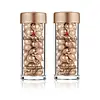What's inside
What's inside
 Key Ingredients
Key Ingredients

 Benefits
Benefits

 Concerns
Concerns

No concerns
 Ingredients Side-by-side
Ingredients Side-by-side

Oryza Sativa Bran Oil
EmollientPersea Gratissima Oil
Skin ConditioningUbiquinone
AntioxidantHelianthus Annuus Seed Oil
EmollientCoco-Caprylate/Caprate
EmollientSimmondsia Chinensis Seed Oil
EmollientC13-14 Alkane
SolventIsostearyl Isostearate
EmollientCaryodendron Orinocense Seed Oil
EmollientSilybum Marianum Seed Oil
Skin ConditioningAscorbyl Tetraisopalmitate
AntioxidantParfum
MaskingAlgae Extract
EmollientCaprylic/Capric Triglyceride
MaskingLavandula Stoechas Extract
MaskingTocopherol
AntioxidantRosmarinus Officinalis Leaf Extract
AntimicrobialBenzyl Salicylate
PerfumingCoumarin
PerfumingLinalool
PerfumingLimonene
PerfumingAlpha-Isomethyl Ionone
PerfumingOryza Sativa Bran Oil, Persea Gratissima Oil, Ubiquinone, Helianthus Annuus Seed Oil, Coco-Caprylate/Caprate, Simmondsia Chinensis Seed Oil, C13-14 Alkane, Isostearyl Isostearate, Caryodendron Orinocense Seed Oil, Silybum Marianum Seed Oil, Ascorbyl Tetraisopalmitate, Parfum, Algae Extract, Caprylic/Capric Triglyceride, Lavandula Stoechas Extract, Tocopherol, Rosmarinus Officinalis Leaf Extract, Benzyl Salicylate, Coumarin, Linalool, Limonene, Alpha-Isomethyl Ionone
Dicaprylyl Carbonate
EmollientCoco-Caprylate/Caprate
EmollientDimer Dilinoleyl Dimer Dilinoleate
EmollientTetrahexyldecyl Ascorbate
AntioxidantTocopheryl Acetate
AntioxidantC12-15 Alkyl Benzoate
AntimicrobialCaprylic/Capric Triglyceride
MaskingCeramide NP
Skin ConditioningCeramide Ns
Skin ConditioningDiethylhexyl Syringylidenemalonate
Skin ProtectingGlyceryl Dioleate
EmollientHelianthus Annuus Seed Oil
EmollientOlea Europaea Fruit Oil
MaskingPersea Gratissima Oil
Skin ConditioningPhytosphingosine
Skin ConditioningPhytosterols
Skin ConditioningPropylene Glycol Dicaprylate/Dicaprate
EmollientSclareolide
MaskingTocopherol
AntioxidantTriolein
Skin ConditioningPhenoxyethanol
PreservativeDicaprylyl Carbonate, Coco-Caprylate/Caprate, Dimer Dilinoleyl Dimer Dilinoleate, Tetrahexyldecyl Ascorbate, Tocopheryl Acetate, C12-15 Alkyl Benzoate, Caprylic/Capric Triglyceride, Ceramide NP, Ceramide Ns, Diethylhexyl Syringylidenemalonate, Glyceryl Dioleate, Helianthus Annuus Seed Oil, Olea Europaea Fruit Oil, Persea Gratissima Oil, Phytosphingosine, Phytosterols, Propylene Glycol Dicaprylate/Dicaprate, Sclareolide, Tocopherol, Triolein, Phenoxyethanol
Ingredients Explained
These ingredients are found in both products.
Ingredients higher up in an ingredient list are typically present in a larger amount.
This ingredient is an emollient, solvent, and texture enhancer. It is considered a skin-softener by helping the skin prevent moisture loss.
It helps thicken a product's formula and makes it easier to spread by dissolving clumping compounds.
Caprylic Triglyceride is made by combining glycerin with coconut oil, forming a clear liquid.
While there is an assumption Caprylic Triglyceride can clog pores due to it being derived from coconut oil, there is no research supporting this.
Learn more about Caprylic/Capric TriglycerideCoco-Caprylate/Caprate is created from fatty coconut alcohol, caprylic acid, and capric acid.
It is a lightweight emollient. Emollients create a thin barrier on the skin to trap moisture in. This helps keep your skin hydrated and soft.
Once applied, Coco-Caprylate/Caprate is absorbed quickly and leaves a silky feel.
Coco-Caprylate/Caprate may not be fungal acne safe.
Learn more about Coco-Caprylate/CaprateHelianthus Annuus Seed Oil is the oil derived from the seeds of a Sunflower. Sunflower seed oil is non-fragrant. It is an emollient, meaning it helps to soften the skin.
Sunflower seed oil contains many fatty acids. The fatty acids found in sunflower seeds include (from highest amount to least): linoleic acid, myristic acid, palmitic acid, stearic acid, arachidic acid, oleic acid, and linolenic acid.
These fatty acids help the skin create ceramides. Ceramides play a role in repairing the skin barrier.
Helianthus Annuus Seed Oil helps moisturize the skin. This in turn helps the skin look more rejuvenated and smoother.
Sunflowers are rich in vitamin E.
Historians believe Indigenous cultures of North America domesticated sunflowers before corn. Thus they relied on sunflower oil for a variety of uses. One such use is moisturizing skin and hair.
Sunflower seed oil may not be fungal acne safe. We recommend speaking with a professional if you have any concerns.
Learn more about Helianthus Annuus Seed OilPersea Gratissima Oil is also known as avocado oil.
Avocado Oil has antioxidant properties. It is mostly made up of the glycerides of fatty acids. About 67% of these fatty acids is made up of oleic acid. Palmitic acid and linoleic acid are also present.
These fatty acids help hydrate and soften the skin. It may increase collagen content in the skin. Collagen helps keep your skin plump and firm. This ingredient helps reduce inflammation and has not shown to clog pores.
This ingredient may not be fungal-acne safe due to its high fatty acid content.
Avocados also have B vitamins, vitamin K, vitamin C, vitamin E, and potassium.
Learn more about Persea Gratissima OilTocopherol (also known as Vitamin E) is a common antioxidant used to help protect the skin from free-radicals and strengthen the skin barrier. It's also fat soluble - this means our skin is great at absorbing it.
Vitamin E also helps keep your natural skin lipids healthy. Your lipid skin barrier naturally consists of lipids, ceramides, and fatty acids. Vitamin E offers extra protection for your skin’s lipid barrier, keeping your skin healthy and nourished.
Another benefit is a bit of UV protection. Vitamin E helps reduce the damage caused by UVB rays. (It should not replace your sunscreen). Combining it with Vitamin C can decrease sunburned cells and hyperpigmentation after UV exposure.
You might have noticed Vitamin E + C often paired together. This is because it is great at stabilizing Vitamin C. Using the two together helps increase the effectiveness of both ingredients.
There are often claims that Vitamin E can reduce/prevent scarring, but these claims haven't been confirmed by scientific research.
Learn more about Tocopherol